

Visible learning. IDEA_Paper_49.pdf. Visible Learning for Teachers. Glossary of Hattie's influences on student achievement. This Glossary explains influences related to student achievement published in John Hattie’s Visible Learning for teachers (Hattie 2012; 251ff).
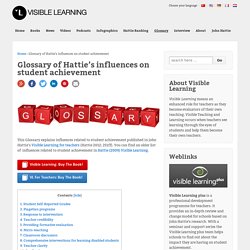
You can find an older list of influences related to student achievement in Hattie (2009) Visible Learning. 1. Student Self-Reported Grades Self reported grades comes out at the top of all influences. Children are the most accurate when predicting how they will perform. Example for Self-reported grades: Before an exam, ask your class to write down what mark the student expects to achieve. Hattie cites five meta-studies: Mabe/West (1982): Validity of self-evaluation of ability (Abstract)Fachikov/Boud (1989): Student Self-Assessment in Higher Education (Abstract)Ross (1998): Self-assessment in second language testing (Abstract)Falchikov/Goldfinch (2000): Student Peer Assessment in Higher Education (Abstract)Kuncel/Crede/Thomas (2005); The Validity of Self-Reported Grade Point Averages, Class Ranks, and Test Scores (Abstract) 2. 3. 4. 5. 6. 7. 8. 9.
What works best. This page has now been revised (May 2010) in the light of John Hattie's recent apparently definitive work Visible Learning; a synthesis of over 800 meta-analyses relating to achievement (London; Routledge, 2009).
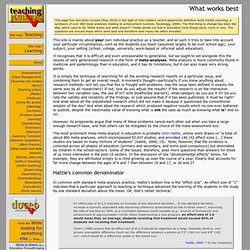
The first thing to change has been the title, which used to be "What works and what doesn't". Hattie points out that in education most things work, more or less. The questions are around those which work best and therefore best repay the effort invested. This site is mainly about your own individual practice as a teacher, and as such it tries to take into account your particular circumstances, such as the students you teach (assumed largely to be over school-age), your subject, your setting (school, college, university, work-based or informal adult education). It recognises that it is difficult and even unreasonable to generalise, but we ought to set alongside this the results of very generalised research in the form of meta-analyses.
Education Week. What works in education – Hattie’s list of the greatest effects and why it matters. I have been a fan of John Hattie’s work ever since I encountered Visible Learning.
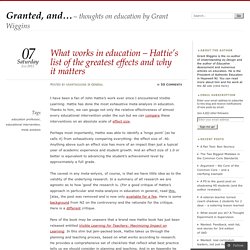
Hattie has done the most exhaustive meta-analysis in education. Thanks to him, we can gauge not only the relative effectiveness of almost every educational intervention under the sun but we can compare these interventions on an absolute scale of effect size. Perhaps most importantly, Hattie was able to identify a ‘hinge point’ (as he calls it) from exhaustively comparing everything: the effect size of .40. Anything above such an effect size has more of an impact than just a typical year of academic experience and student growth. And an effect size of 1.0 or better is equivalent to advancing the student’s achievement level by approximately a full grade. The caveat in any meta-anlysis, of course, is that we have little idea as to the validity of the underlying research. Can you guess the next two items on the rank order list? “Home environment” and “socio-economic status.” Like this: Like Loading... What can we learn from John Hattie. Ask not what works; instead ask: what works best?
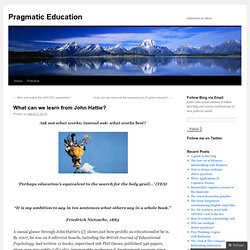
‘Perhaps education’s equivalent to the search for the holy grail…’ (TES) “It is my ambition to say in ten sentences what others say in a whole book.” Friedrich Nietzsche, 1885 A casual glance through John Hattie’s CV shows just how prolific an educationalist he is. By 2007, he was on 8 editorial boards, including the British Journal of Educational Psychology, had written 12 books, supervised 168 PhD theses, published 546 papers, given over 700 public talks plus innumerable professional development sessions since 1989, and run workshops for thousands of teachers in thousands of schools.
Hattie has also collated the largest ever collection of evidence-based research in the educational world. His next book, Maximising Impact on Learning (2012), the biggest ever research project on teaching, took the numbers to over 900 meta-analyses over 18 years. “Now you see it…”: the magic of direct instruction and feedback. Ten sentences in his own words: 1. Education Week. Educational publisher Corwin Press announced that they are bringing the work of New Zealand born educational researcher John Hattie to North America.
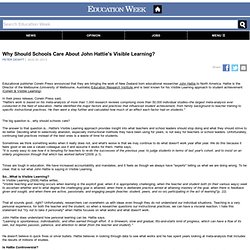
Hattie is the Director of the Melbourne (University of Melbourne, Australia) Education Research Institute and is best known for his Visible Learning approach to student achievement (Corwin & Visible Learning). In their press release, Corwin Press said, "Hattie's work is based on his meta-analysis of more than 1,000 research reviews comprising more than 50,000 individual studies--the largest meta-analysis ever conducted in the field of education. Hattie identified the major factors and practices that influenced student achievement, from family background to teacher training to specific instructional practices. He then went a step further and calculated how much of an effect each factor had on students.
" The big question is...why should schools care? Times are tough in education.